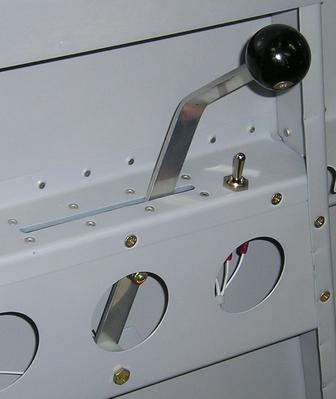It's been a busy week, but unfortunately not much of the activity has been on the aircraft project. Tuesday I hooked up the Microair 760 com to the under-fuselage antenna and the audio panel. It receives the ATIS nicely. I still need to track down a handheld VHF to confirm both radios transmit OK. I thought I had a problem with the mic from the rear seat, so I pulled the audio panel harness back out to give it another wring out with the ohmmeter. It was fine, and it worked perfectly when I put it back in the aircraft. I think the problem could have been that one of the DB-25 plugs wasn't fully engaged on the back of the audio panel.
 Then I was in Montreal for a few days - I got back late Saturday afternoon. The correct switch for the rear seat pitch trim arrived while I was away, so today I installed it. The switch for the pitch trim power in the front cockpit has three positions: OFF, Front Seat Only and Front and Rear Seats. That way I can disable the rear seat trim switch when I have a none-pilot in back.
Then I was in Montreal for a few days - I got back late Saturday afternoon. The correct switch for the rear seat pitch trim arrived while I was away, so today I installed it. The switch for the pitch trim power in the front cockpit has three positions: OFF, Front Seat Only and Front and Rear Seats. That way I can disable the rear seat trim switch when I have a none-pilot in back.
I spent quite a while today working my way through the multitude of configuration setup pages on the GNS-430 and GTX-327. There are dozens of options to set to tell the units what inputs and outputs they are dealing with. I realized a while ago that the GNS-430 wasn't receiving altitude data from the transponder - it turns out that this is one of the options that must be set. I had also been concerned about a 5° error in the CDI course output - there is a configuration page that allows you to calibrate the CDI input, so now the error is less than 2° everywhere.
And then I spent quite a while puzzling over annunciator dimming. I've got four LED annunciators that I need to deal with. All will be unlit most of the time, but they could be illuminated for long periods if they are annunciating a system failure. All of them are driven by a 12V signal when they are in the ON state. I.e 12V = ON, 0V = OFF.
Read on for the rest of the story.
I had planned on running the ground returns for all of them through a rotary potentiometer, but now that I start looking, I can't find a potentiometer that controls four outputs.
My next idea was to power the annunciators with a small solid state dimmer module, and to use relays to control the ground return from each annunciator. But that requires a relay for each annunciator, so I'm not happy about the complexity.
The only simple solution I could think of was to run the ground returns for all annunciators through a single potentiometer. The intensity would vary depending on how many annunciators are lit, but the vast majority of cases would only have one lit at a time, so this might be workable.
I had run out of ideas, so I posted a question to the Aeroelectic-List this afternoon. Bob Nuckolls responded:
Okay, this means that they all share a common ground. To apply equal dimming to the entire array, select a zener diode (1-watt 1N4700 series is fine) that provides the right voltage drop for the dim position. Put this zener in series with the ground for all lamps. Put a bright/dim toggle switch in parallel with the zener. Close the switch for max-bright operation, open for dimmed operation.
See: http://216.55.140.222/temp/annun_dim.gif
Bob . . .
This looks like it could work, once I figure out what value zener I need.